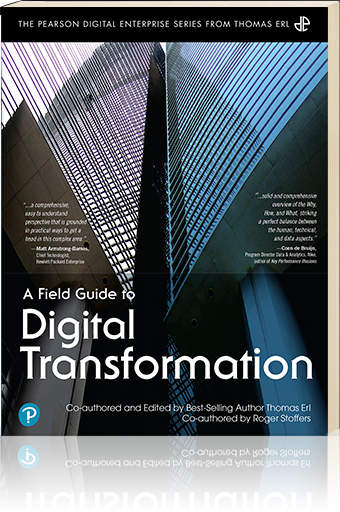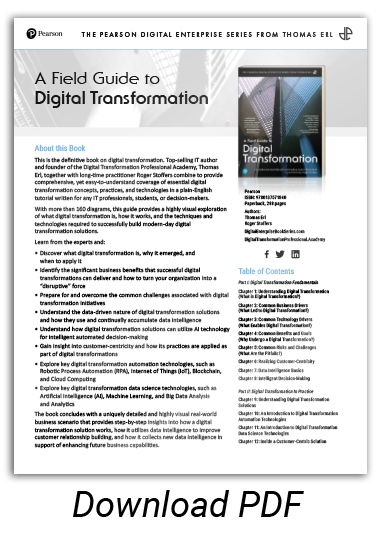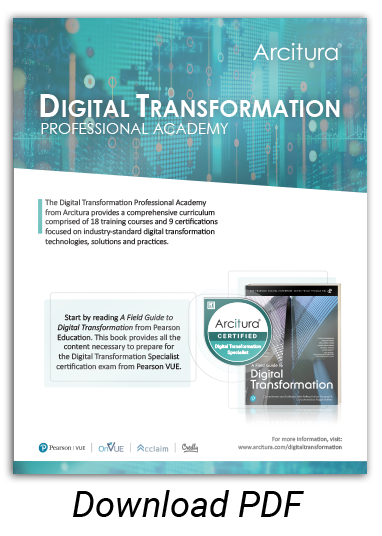Acknowledgments
Reader Services
PART I: DIGITAL TRANSFORMATION FUNDAMENTALS
Chapter 1: Understanding Digital Transformation (What is Digital Transformation?)
Business, Technology, Data and People
Digital Transformation and Business
Digital Transformation and Technology
Digital Transformation and Data
Digital Transformation and People
Digital Transformation and Organizations and Solutions
Chapter 2: Common Business Drivers (What Led to Digital Transformation?)
Losing Touch with Customer Communities
Inability to Grow in Stale Marketplaces
Inability to Adapt to Rapidly Changing Marketplaces
Cold Customer Relationships
Inefficient Operations
Inefficient Decision-Making
Chapter 3: Common Technology Drivers (What Enables Digital Transformation?)
Enhanced and Diverse Data Collection
Contemporary Data Science
Sophisticated Automation Technology
Autonomous Decision-Making
Centralized, Scalable, Resilient IT Resources
Immutable Data Storage
Ubiquitous Multiexperience Access
Chapter 4: Common Benefits and Goals (Why Undergo a Digital Transformation?)
Enhanced Business Alignment
Enhanced Automation and Productivity
Enhanced Data Intelligence and Decision-Making
Improved Customer Experience and Customer Confidence
Improved Organizational Agility
Improved Ability to Attain Market Growth
Chapter 5: Common Risks and Challenges (What Are the Pitfalls?)
Poor Data Quality and Data Bias
Increased Quantity of Vulnerable Digital Data
Resistance to Digital Culture
Risk of Over-Automation
Difficult to Govern
Chapter 6: Realizing Customer-Centricity
What Is a Product?
What Is a Customer?
Product-Centric vs. Customer-Centric Relationships
Transaction-Value vs. Relationship-Value Actions
Customer-Facing vs. Customer-Oriented Actions
Relationship Value and Warmth
Warmth in Communication
Warmth in Proactive Accommodation
Warmth in Customer Rewards
Warmth in Exceeding Customer Expectations
Single vs. Multi vs. Omni-Channel Customer Interactions
Customer Journeys
Customer Data Intelligence
Chapter 7: Data Intelligence Basics
Data Origins (Where Does the Data Come From?)
Corporate Data
Third-Party Data
Creating New Corporate Data Intelligence
Common Data Sources (Who Produces the Data?)
Operations Data
Customer Data
Social Media Data
Public Sector Data
Private Sector Data
Data Collection Methods (How Is the Data Collected?)
Manual Data Entry
Automated Data Entry or Collection v
Telemetry Data Capture
Digitization
Data Ingress
Data Utilization Types (How Is the Data Used?)
Analysis and Reporting
Automated Decision-Making
Solution Input
Bot-Driven Automation
Model Training and Retraining
Historical Record Keeping
Chapter 8: Intelligent Decision-Making
Manual Decision-Making
Computer-Assisted Manual Decision-Making
Conditional Automated Decision-Making
Intelligent Manual Decision-Making
Intelligent Automated Decision-Making
Direct-Driven Automated Decision-Making
Periodic Automated Decision-Making
Realtime Automated Decision-Making
Intelligent Manual vs. Intelligent Automated Decision-Making 115
PART II: DIGITAL TRANSFORMATION IN PRACTICE
Chapter 9: Understanding Digital Transformation Solutions
Distributed Solution Design Basics
Data Ingress Basics
File Pull
File Push
API Pull
API Push
Data Streaming
Common Digital Transformation Technologies
Chapter 10: An Introduction to Digital Transformation Automation Technologies
Cloud Computing
Cloud Computing in Practice
Common Risks and Challenges
Blockchain
Blockchain in Practice
Partial Business Data Capture
Full Business Data Capture
Log Data Access Capture
Partial Business Data Store
Ledger Export
Common Risks and Challenges
Internet of Things (IoT)
IoT Devices
IoT in Practice
Common Risks and Challenges
Robotic Process Automation (RPA)
RPA in Practice
Common Risks and Challenges
Chapter 11: An Introduction to Digital Transformation Data Science Technologies
Big Data Analysis and Analytics
The Five V’s of Big Data
Big Data in Practice
Common Risks and Challenges
Machine Learning
Model Training
Machine Learning in Practice
Common Risks and Challenges
Artificial Intelligence (AI)
Neural Networks
Automated Decision-Making
AI in Practice
Common Risks and Challenges
Chapter 12: Inside a Customer-Centric Solution
Supporting Data Sources
Step-by-Step Business Process
Step 1.Customer Visits Dealership
Step 2.Customer Makes Inquiry
Step 3.Options Shown to Customer
Step 4.Price Shown to Customer
Step 5.Customer Places Order?
Step 6.Customer Leaves
Step 7.Customer Accesses Profile
Step 8.Dealership Follows Up
Step 9.Process Order and Update Customer Account
Step 10.Production Scheduling Change?
Step 11.Customer is Notified
Step 12.Manufacturer Ships Car
Step 13.Dealership Provides Car
Step 14.Dealership Offers Plan
Step 15.Customer Accepts Plan?
Step 16.Customer Takes Unmonitored Car
Step 17.Process Order and Update Account
Step 18.Sensor Installed in Car
Step 19.Customer Takes Monitored Car
Step 20.Dealership Follows Up
Step 21.Dealership Offers Trade-in
Step 1: Customer Visits Dealership (Again)
Future Decision-Making
About the Authors
Thomas Erl
Roger Stoffers




